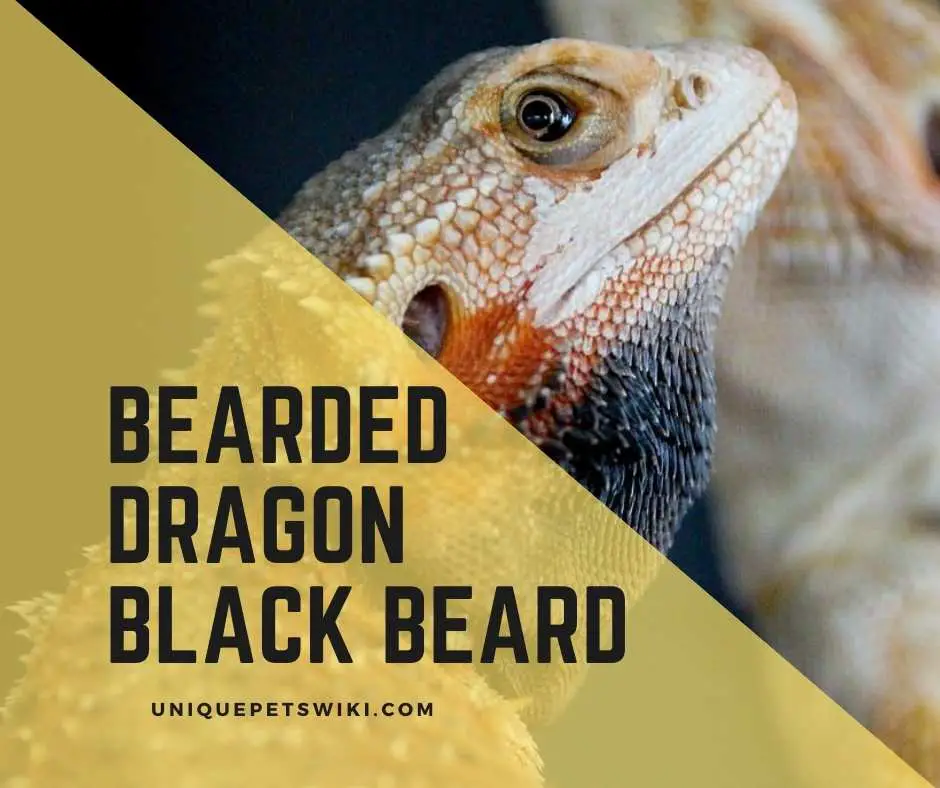Have you ever noticed your bearded dragon beard turning black? If your beardie turns it beard black, something is wrong, or there is nothing to worry you.
We are going to learn the reasons for a bearded dragon black beard, and when to be worrying. Generally, a black beard may indicate that there is something wrong internally or in the environment.
A dragon darkens its beard more often and on several occasions. It is a good way to tell if your beardie is having a problem or not.
Let’s take a look at the various instances when a bearded dragon beard becomes black.
Contents
- Why Does a Bearded Dragon Beard Turn Black?
- This is My Territory
- Black Bearding is Common During Mating Seasons
- A Black Beard can be a Sign that Your Beardie is Sick
- Bearded Dragon Black Beard may be Due to Stress
- It is a Sign that the Beardie is not Happy
- They are Uncomfortable
- The beardie is Regulating its Body Temperature
- A Beard Turning Black Immediately After Brumation
- Placing the Enclosure Near the Window
- Black Beard as a Natural Coloration
- Black Beard may Indicate that the Beardie Needs Your Attention
- How to Bond with Your Bearded Dragon
- Why Do Bearded Dragons Tail Turn Black?
- Conclusion
Why Does a Bearded Dragon Beard Turn Black?

You should pay attention to your beardie more often to check at anything unusual. As I have said, a beard may obtain a black color as a sign that the beardie is unhealthy. On such an occasion, you will want to act quickly.
At times, it may be difficult to pinpoint why your beardie lizard displays a black beard, and if it is something to make you worry.
By the end of the article, you will be able to understand the reasons why these lizards display such behavior.
Here are the reasons for a bearded dragon black beard. Read on for detailed information.
This is My Territory
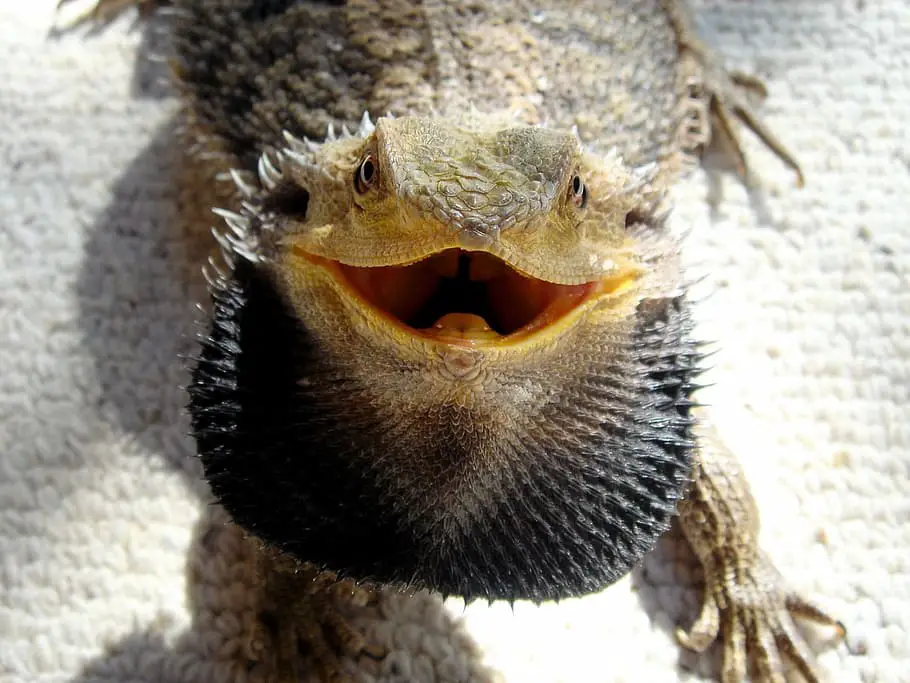
Sometimes you may want to have probably two beardies in a cage for certain reasons but in that case expect some pretty bad fights, especially with males.
Black bearding is common with the beardies when they are guarding their territory. It is a sign of authority expressed by dominant beardies to warn other smaller males and also females trying to get into the territory.
Apart from black bearding, you may also notice your beardie bobbing its head and sometimes hissing.
When a dragon wants to be alone, it can also display these behaviors to keep you away from its territory. If that happens, don’t disturb your beardie, allow it to calm down.
Female beardies living together can also get into a fight, particularly when fighting over food, heat, space, etc. The female that is dominating is always the winner, while those that are being dominated can miss almost everything if you are not careful.
The only time when you may house the beardies together is after hatching due to the many hatchlings, and this should not go beyond three months. Again, you will need to pay close attention to them.
Black Bearding is Common During Mating Seasons
Typically, male bearded dragons get more territorial when they want to mate. During the breeding season, the beard blackens regularly to indicate the male is ready to mate. It happens when there is a female around.
Bearded dragons mate mainly during spring. If you notice a black beard in your dragon during this time, which is accompanied by head-bobbing, it’s something natural. There is nothing to worry you; the beardie is only looking forward to mate.
Sometimes the beardie can become aggressive during mating season; avoid unnecessary handlings during those moments.
A black beard and head-bobbing is a sign to the females that the male is aroused. If the female is ready to mate, she responds by bobbing her head slowly that is accompanied by an arm-waving gesture.
A Black Beard can be a Sign that Your Beardie is Sick
A beard can turn black when the beardie is unhealthy. Since black bearding may occur due to many reasons, a black beard is not enough to tell if your lizard is sick.
You need to be familiar with other symptoms of a sick dragon; it will help you know if the beardie is fine or not. For instance, you may notice a beardie darkening not only its beard but also the other parts of the body. It is not a normal occurrence.
New to bearded dragon? Check out the bearded dragon care sheet now! We had listed out all the things you need to know about bearded dragons as pets. Check it now!
Make sure to contact or take the lizard to a reptile veterinarian for diagnosis and treatment, in case of any illness such as metabolic bone disease.
Check your beardie regularly and keenly; sometimes, it can be hard to identify a sick dragon.
Bearded Dragon Black Beard may be Due to Stress
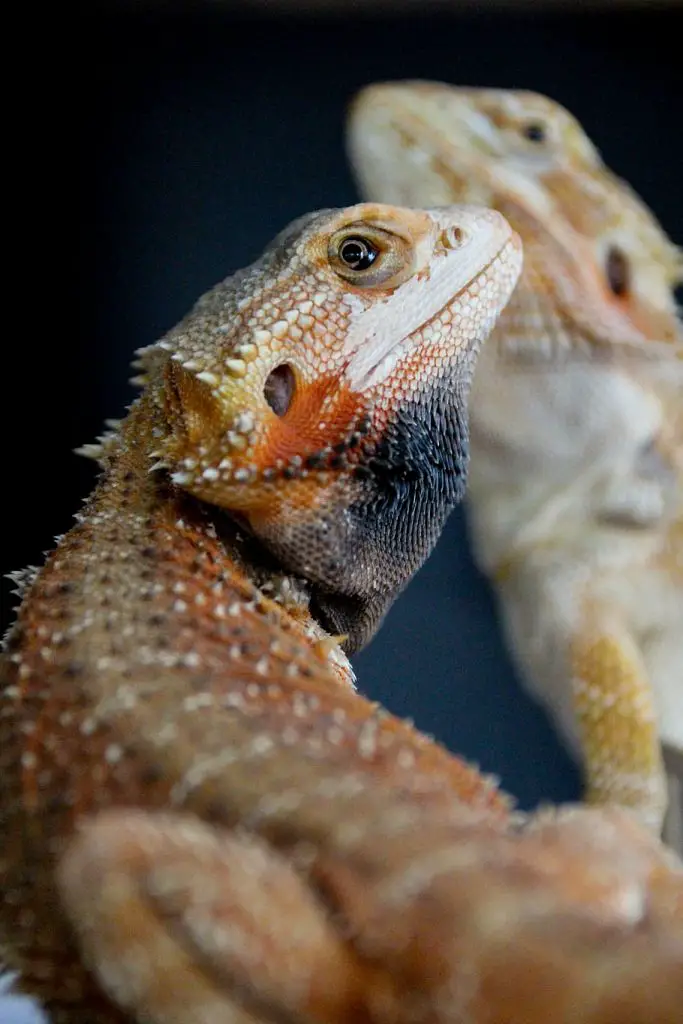
A beardie may be subjected to stress if things are not correct in the enclosure- for example, due to insufficient lighting and heating, inadequate food, and more. A different pet can also be the cause of the stress to a beardie.
If it is stress causing the beardie to turn its beard from the specific normal color to black, you can easily notice, especially when the beardie looks disturbed. You will want to check if the temperatures in the cage are right and adjust them.
You will also need to ensure that the beardie is not exposed to other pets such as dogs or cats that may be scaring it.
A bearded dragon will also blacken its beard and puff up to make it appear tougher and big towards other pets. It is a way to defend itself.
There is nothing to worry about if the beardie displays this behavior on several occasions when they encounter the other pets in your house.
However, if the behavior is persistent, you will need to look for a decent and secure place where these pets cannot access to place the dragon.
It is a Sign that the Beardie is not Happy
How does your child behave when they are angry? They tend to puff up their faces and become furious, right? It is the same with bearded dragons; they can’t hide whey they are mad.
A beardie that is annoyed shows a black beard, and this means that you should not mess with it. Interfering with them means you are giving them more reasons to be unhappy.
You may observe your beardie changing its beard color to black when bathing it, look for an alternative, like misting if that is the case. Don’t expose your beardie to what you know well it doesn’t appreciate to prevent straining its immune system, which can be dangerous.
They are Uncomfortable
If you recently purchased your bearded dragon and realized its beard blackening, especially when trying to handle it, it means the lizard is unfamiliar with you and doesn’t trust you. Give a couple of days or weeks for the beardie to adjust.
Every reptile enthusiast will always desire to have a good bond with their pets. It is indeed a good idea and is practical with a bearded dragon because of their affectionate personality. However, give your beardie time to learn and bond with you.
It is also typical for a bearded dragon to blacken its beards in new surroundings when it feels uncomfortable. It could be due to the dragon coming to a new home, or when you change or introduce materials like furniture in the tank.
It will only take place for a few days, and things will be normal. But you can consider removing the item if the dragon is perpetually disturbed.
The beardie is Regulating its Body Temperature
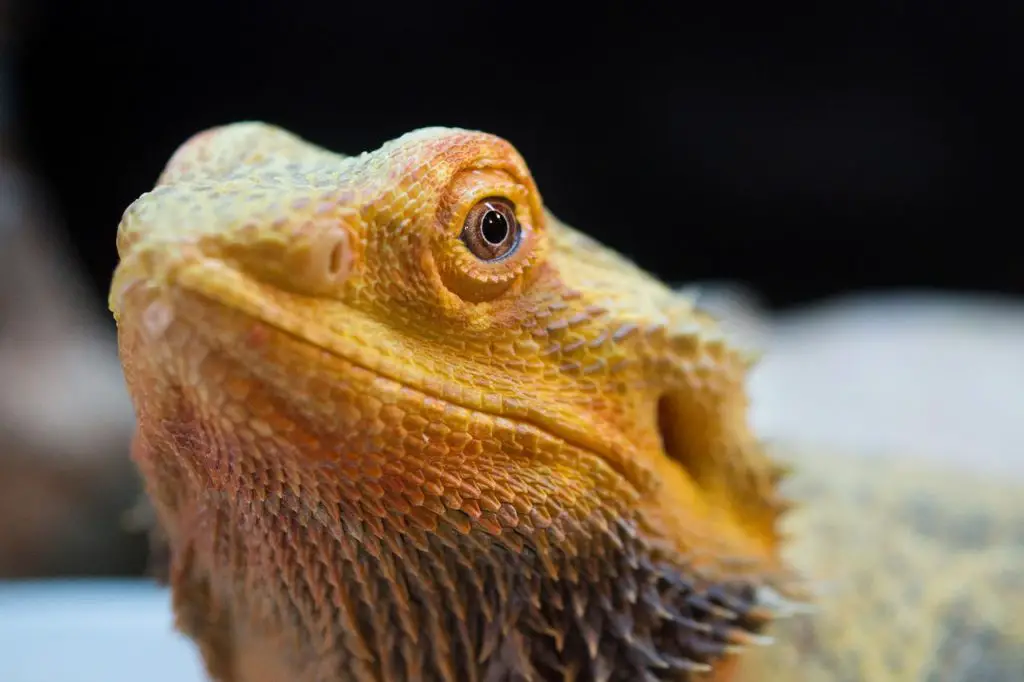
The temperatures in the enclosure vary greatly between the day and night. At night, the beardies prefer cooler temperatures compared to hot temperatures during the day. This makes their body to be colder in the morning when they wake up.
Therefore, as cold-blooded animals, the beardies will need to raise their body temperature. Typically, a beardie will turn its beard and the body to black to help warm the body faster. This may happen more often in the morning, but only for a few hours and the normal color resumes.
You may also realize your beardie is changing its color to black when basking in the sun for the same purpose. This behavior is common with wild bearded dragons that usually bask in the sun to regulate their body temperature.
Always ensure that the temperatures in the enclosure are correct to help your beardie live comfortably and healthy. The basking area should range anywhere from 95-110℉, and the cool spot 75-90℉ depending on the age of the beardie.
A Beard Turning Black Immediately After Brumation
It is possible to see a bearded dragon having a black beard when it recently comes out of hibernation. After a deep sleep for quite a pretty long time, the beardie is trying to readjust to the long hours of light and regaining its appetite; this can affect its attitude.
A change in attitude can easily make the bearded dragon have a black beard, but it will only take place for several days or weeks.
Placing the Enclosure Near the Window
What is the condition in your area, do you have trees? Having a beardie tank close to the window, particularly in the areas where there are trees may not always be a good option. Your beardie may be threatened by the trees swaying, or birds making noise.
They may also see children playing outside or other things that can upset them. If you have the enclosure near a window and your beardie seems to darken its beard more often, something from outside might be upsetting it.
If that is happening to your pet, place the tank far away from the window for several days to see how it behaves. If the behavior ceases, know for sure that there is something outside threatening your pet. Choose always to keep the cage away from the window.
However, in situations where the terrarium is near the window, and the beardie occasionally turns its beard to black, it might not be a problem.
New to bearded dragon? Check out the bearded dragon care sheet now! We had listed out all the things you need to know about bearded dragons as pets. Check it now!
Black Beard as a Natural Coloration
The most exciting thing in some morphs of bearded dragons, especially the babies, as they are growing is how they can change their standard color to a different color. In the process, the beardie’s beard may obtain a black color that remains forever.
Again, this is a natural coloration, and you should not worry about it. In the beginning, you may be concerned, but with time, you will get to understand that it is natural.
Black Beard may Indicate that the Beardie Needs Your Attention
Hanging out with someone you love gives a good feeling, and you will want that to happen again and again, isn’t that so? Bearded dragons also appreciate every treat you give them. They will want to be with you more often, this is how affectionate they can be, and it’s awesome.
After having a precious time walking or playing with your dragon and then you happen to return it to the cage, you may see the beard blackening. It is an indication that the pet enjoyed every activity with you, and it wants to do it again.
Have you ever noticed your bearded dragon turning its beard black and coming closer to the glass to stare at you when you approach the tank? In that situation, the beardie needs nothing but your attention.
How to Bond with Your Bearded Dragon

Be patient with the new dragon as it tries to adapt and familiarize with the new people it finds in your home. Visit the enclosure regularly and talk nicely to the beardie, with time, it will be able to acknowledge you.
After several visits, you can start handling your pet gently and slowly, about a few minutes in a day, and be sure to observe the way it behaves after handling. Next time you can hold your pet for about 30 minutes, and it will learn as you proceed.
You may also need to hand-feed the beardie; it is a good way for your pet to trust you. Always lift and handle your dragon with care to make it continue trusting you.
Why Do Bearded Dragons Tail Turn Black?
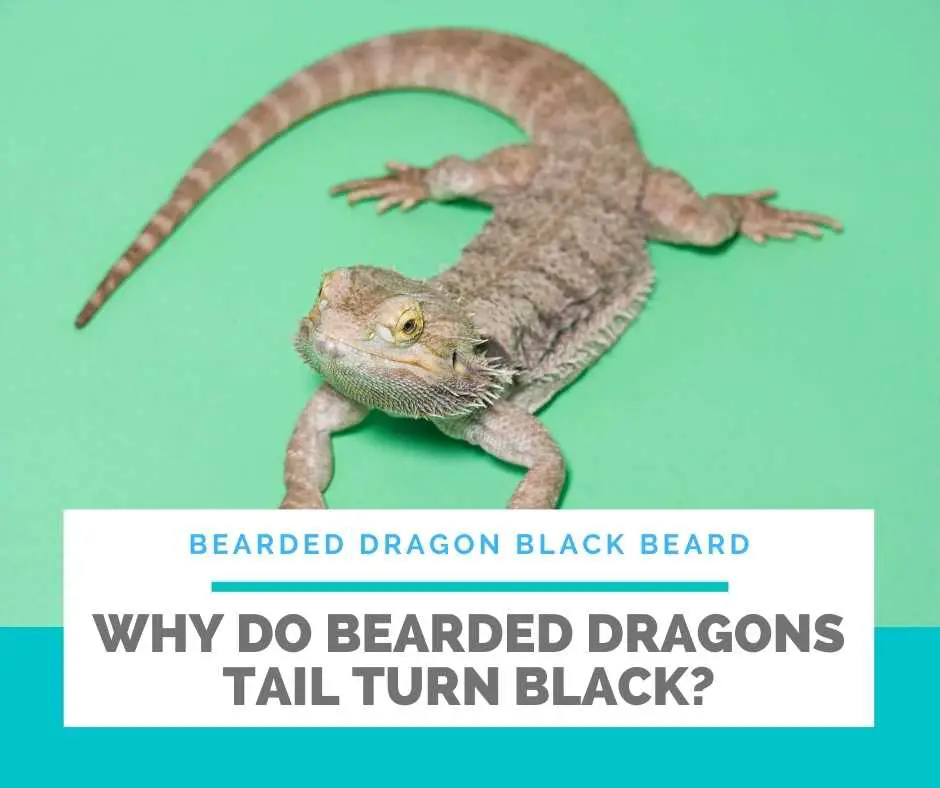
A bearded dragon’s tail can change to black due to some reasons the same way with the beard. The majority of the things that cause the beard to be black can also be the reason for a black tail.
Tail blackening may be due to stress, disease, or the beard is just like that, having a black tail as a standard coloration. Tail rot diseases can make the tail and the beard to turn to black and can cause the beardie to stop eating.
A bearded dragon may suffer from tail rot when there is insufficient blood flowing through the tail. This may be due to partial shedding or trauma. Take the beardie to your reptile vet. After diagnosis, the vet may give out antibiotics or cut off some parts of the tail.
Conclusion
Taking care of your bearded dragon and paying close attention is necessary to help you pinpoint anything unusual. There are many reasons why beardies demonstrate a black tail and beard, which may be from internal issues to changes in the environment.
You should note any changes expressed by your beardie, determine the underlying causes, and act accordingly. Black beard is not something super serious but never ignore it.
